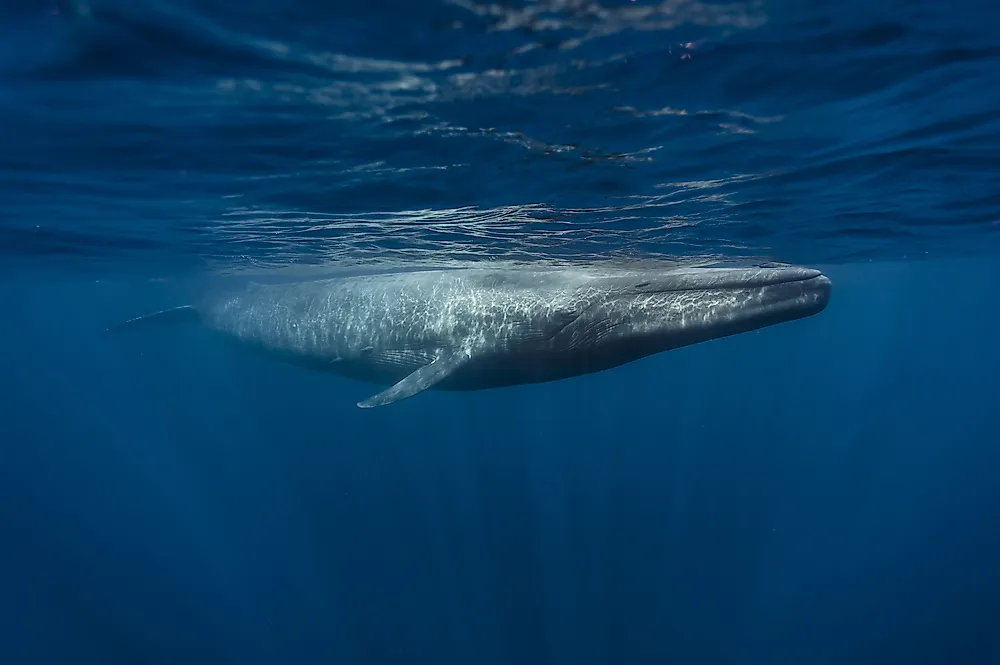10 Amazing Facts About Blue Whales

A blue whale is an aquatic mammal that is classified under the baleen whale species. In scientific terms, it is known as Balaenoptera musculus. The blue whales have three major discrete categories; there is the Balaenoptera musculus which inhabits the North Atlantic and Pacific, Balaenoptera musculus intermedia found in the Southern Ocean, and Balaenoptera musculus brevicauda that dwell in the Indian Ocean and South Pacific Ocean. The blue whale is believed to be among the largest animal to ever exist.
Blue whales are lightly spotted and are bluish-grey with lighter undersides. The lighter undersides are because of accumulation of algae in the colder water, hence the name Sulphur bottom whale. A blue whale has a flat head that is U in shape; it also has a protruding edge that runs from the blowhole to the upper lip. Moreover, the front part of the whale’s mouth comprises 300 baleen plates that help in emptying water from the mouth during feeding. Blue whales receive ranking among the most outstanding creatures based on the facts stated below.
Ten Amazing Facts About Blue Whales
They Are Massive
Blue whales are known to have a massive body physique; they weigh up to approximately 170,000 kilograms (170 to 200 tonnes). Being in the ocean has helped the blue whales retain their huge size without feeling the effect of gravity. Their huge bodies are filled with fat which allows them to enjoy flexibility in water thus preventing them from collapsing under their weight. It is believed that female blue whales weigh more than the male whales. Females weigh 180,000 kilograms (180 tonnes) while the male weighs 130,000 kilograms (130 tonnes). Newborns, on the other hand, weigh about 2,700 kilograms (2.7 tonnes).
They Produce A Loud Sound
Blue whales are unique because of how loud they are. They can make sounds and calls that travel up to 1,600 kilometers (994 miles) away. When compared to a jet engine, a blue whale’s call registers 188 decibels while the engine reaches 140 decibels. Their language comprises wails, groans, and pulsations. Even though they produce a loud sound, their calls are at low frequencies that are below human hearing.
The Young Whales Are Also Large
Blue whales are known for delivering big calves. A blue whale can be rated among the huge mature animals at birth. The weight of a blue whale calf is approximately 8800 pounds, and its length is 26 feet. They have the fastest maturity rate in the animal world as a blue whale gains approximately 200 pounds daily. Baby whales consume about 380 to 570 liters of milk daily, which is equivalent to 4,370 kilocalories per kilogram.
Blue Whales Have Huge Hearts and Tongues
The heart of a blue whale is gigantic. It can be compared to the size of a car, and it weighs approximately 450 kilograms (992 pounds). The pulse of a blue whale can be sensed from two miles away. Besides its huge heart, a blue whale has a massive tongue that weighs same as an elephant. It also has wide blood vessels
Big Appetite For Small Fish
Blue whales are known to feed on crustaceans known as krill. They have a capability of holding 997 kilograms (2,200 pounds) of crustaceans in their stomach at a time. However, to keep satisfied, they need to feed on 4,490 kilograms (9,000 pounds) of krill a day. Blue whales feed at depths of 100 meters (328 feet) during the daytime. They feed by diving forward at groups of krill, taking the fish coupled with water into their mouth. To enable them to gulp the krill, they have to let out water by squeezing it through their baleen plates.
Long Lifespan
Blue whales have long lives and are among earth’s longest-living mammals. Their average lifespan is said to be about 80 to 90 years, although the oldest known blue whale lived for 110 years. The survival of the blue whales depends on whether there is pollution in the water, human beings hunting them down or if there is inadequate food supply.
Ability To Rush
Blue whales often travel great distances, as they move from Polar Regions where they feed during summer and head to the equator as winter approaches. Blue whales can travel up to speeds of 31 miles (50 kilometers) per hour when interacting with other whales, but their normal speed is about 12 miles (20 kilometers) per hour. When feeding, they decelerate to speeds of 5 kilometers per hour.
Introverted Creatures
Blue whales like to travel by themselves single-handedly, and if they have to travel in groups, then their groups do not exceed two whales. Their pairs may often include a mother and her calf or two adults. Blue whales stay several kilometers apart even as they travel in sets due to their timid nature. Blue whales only come together during feeding times.
Few In Number
Catching blue whales was impossible in the past because of their size and speed. However, a Norwegian by the name Stephen Foyn enhanced his steamboat with explosive harpoons. His discovery led to the demise of the blue whales as the invention made it easier for the whales to be hunted down. Initially, Antarctic had the largest population of the blue whales but the number narrowed down to 360 whales after they had been hunted down severely. The remaining number of blue whales is proportional to 0.15 percent of the original number of whales.











